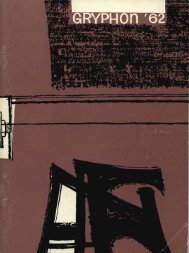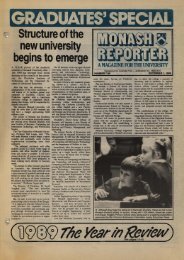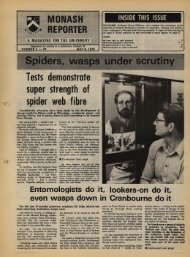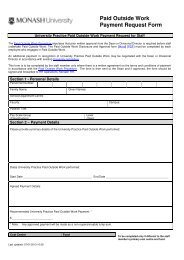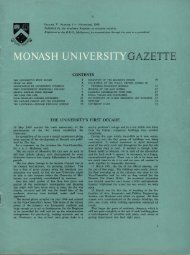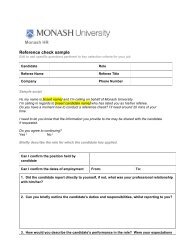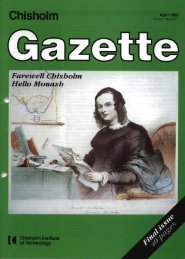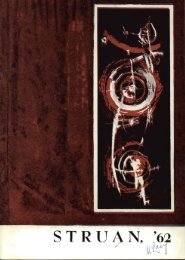Struan 1965 - Adm.monash.edu.au
Struan 1965 - Adm.monash.edu.au
Struan 1965 - Adm.monash.edu.au
- No tags were found...
Create successful ePaper yourself
Turn your PDF publications into a flip-book with our unique Google optimized e-Paper software.
school was Coolbinia Primary School, which goes to Grade 7. All the PrimarySchools in Perth go to Grade 7, then the children go to Junior High School fortwo years, after which they proceed to Senior High School where they do SubLeaving in one year, and Leaving which is a two-year course. After passing theirfinal Leaving Examination they have the equivalent of the Victorian Matriculation.At Coolbinia we were shown over the school by a Mr. Segar, a Nature Studiesexpert attached to the school. A particular feature of this school was the emphasison plants and wildflowers of Western Australia. Numerous gardens and nurserieswere laid out where the children could watch the plants and flowers growing ina "natural" situation. There is a plan for an open air "nature classroom" wherethe children could go for their Nature Study lessons.The Tuart Hill High School came next and was certainly a be<strong>au</strong>tiful school.Completed in 1956 it is a two-storey white brick building with large green tintedwindows to provide plenty of light to the spacious classrooms without allowingtoo much glare. There are 1500 pupils attending the school which has new andefficient science rooms, a lecture theatre (used for lectures and films in science),a swimming pool, large playing fields, and a large assembly courtyard. Thisschool also provides for art and craft subjects such as painting, pottery, woodwork,sewing and mechanical work. There are separate rooms fully equippedfor each of these departments.We then went to Claremont Teachers' College where we were amply entertainedat a luncheon given by the staff and members of the S.R.C. This Collegeis housed in a large two-storey building and differs in appearance from our ownCollege. Some of the lecture rooms here, I thought, were a little small.During the afternoon we inspected the Graylands Teachers' College which issituated at a former Army Barracks w ith the tin and wooden huts and sheds beingturned into lecture theatres. A feature here was that all the students participatein some form of gardening and work around the College for certainperiods each week. A couple of the students who were showing usabout, said, that besides making the surroundings more attractive it helpsto inculcate a better College spirit amongst the inmates. There certainly wasa good atmosphere here at Graylands for the students who showed us aboutand looked after us during afternoon tea were really great guys, er, sorry, gals.The subjects they do are similar to ours but they do about ten subjects in muchless detail.John Forrest National Park and Mundaring Weir were great scenic spots, thelatter with its huge mountains of pine trees and its giant spillway, the formerwith its many wild flowers and native trees. ,A highlight of the whole tou r was the trip to Rottnest Island, which is 12 milesoff the coast of Australia near Fremantle. The island is picturesque with its ruggedhills, its trees and wildflowers and its jagged cliffs stretching down to the greatcrashing waves of the Indian Ocean. On the island there are small brown, furry,four-legged animals called Quokkas, which are something like a wombat. Theyare blind in the daytime but can smell any food that you hold close and willcome right up and eat bread from your hand. Some of the bays and beacheson the island are superb and very popular in summer. On one of the rocky cliffswe saw several red and yellow crabs and we were all fascinated by their quaintsideways crawl. The trip back on the ferry, the "Katemeraire", was really enjoyablewith a grand old singalong with Mr. Howe providing some lovely numbers.21




